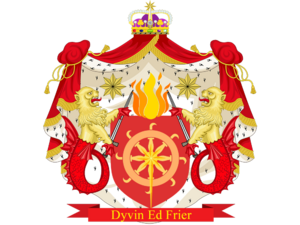Politics of Chatten and Leucen
| Federal parliamentary constitutional monarchy | |
 | |
| Constitution | Constitution of Chatten and Leucen |
|---|---|
| Country | Chatten and Leucen |
| Legislative branch | |
| Legislature | Chalcish Parliament |
| Meeting place | Horessen Palace |
| Executive branch | |
| Head of State | Monarch |
| Head of Government | Prime Minister |
| Appointer | Megysmund XI |
| Headquarters | Horessen Palace |
| Departments | List
|
| Judicial branch | |
| Court | Supreme Court of Chalcain |
| Seat | Magnanon Hall |
Chatten and Leucen is a federal parliamentary and constitutional monarchy, where federal legislative power is vested in the bicameral Chalcish Parliament, divided into two elected chambers: the House of Baronies (representatives of the kingdom's federal states), and the Assembly of Commons.
The Social Democratic Party of Chalcain, since 1945, has been the incumbent party of the kingdom until 2004, where the Nationalist Party won the 2004 general elections during the controversy period of the SPDC's support on the Federal States' War on Terror by ratifying the Act of Agreement and Support for the War on Terror. The judiciary of the Northern Kingdom is independent of the executive and the legislative, and it is very uncommon for the members of the Parliament to become associate judges. While it is legally allowed, it is met with extreme suspicion. The basic foundation and workings of the Government is laid out in the Constitution of Chatten and Leucen, a collection of laws, precedents, previous acts, and statues which was ratified in 1949 near the end of the July Revolution. The leader of the biggest party on both the House of Baronies and the Assembly of Commons combined would be given the privilege of choosing the Prime Minister. Since 2022, the current prime minister is Saiah Dunwille.
The constitution was compiled in the wake of the revolution to clearly defined the powers of the Monarchy and the Parliament, asserting parliamentary sovereignty. It defines the division and strict implementation of roles between the legislative, executive, and judicial branches and limits the power of the Monarch to dissolve the Parliament, now requiring a supermajority vote on the Parliament in order to do so. This is to ensure that the Monarch would not be able to overhaul the entire parliament and his ministers in a single stroke, a lesson learned after the July Revolution. Furthermore, the constitution become an opportunity to ensure Individual liberty for all citizens. It also includes a catalogue of human and civil rights that aims to protect the citizenry against the possible emergence of an oppressive, authoritarian government.